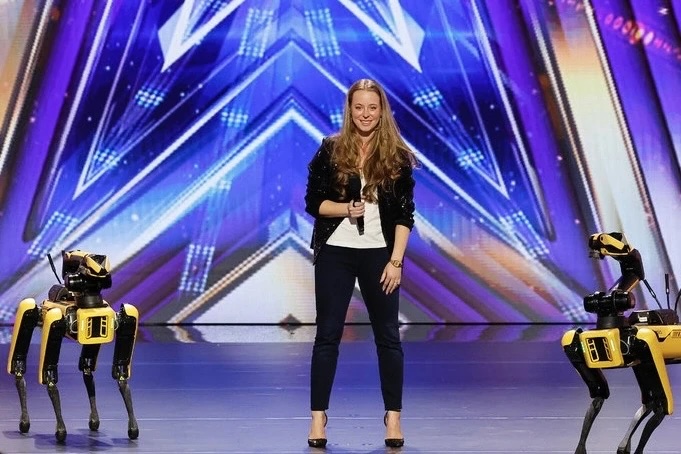Boston Dynamics is no stranger to the spotlight. Its Atlas humanoid and Spot quadruped robots have become global phenomena thanks to viral videos showcasing their agility, stability, and, of course, dancing.
Earlier this year, the company took things to a new level. It had five Spot robots perform a live, choreographed dance routine on NBC’s America’s Got Talent (AGT), one of the biggest stages in entertainment. The legged robots performed a synchronized dance to Queen’s “Don’t Stop Me Now,” and the robot arm on each robot was used to “lip-sync” to Freddie Mercury’s vocals.
All four AGT judges — Simon Cowell, Mel B, Howie Mandel and Sofia Vergara — voted “yes” for Spot to move on to the next round of the competition. What appeared to the average viewer as a fun robotics demo was also a technical stress test for Spot and Boston Dynamics’ robotics engineers behind the scenes.
“After 20 years, how can we see something we’ve never seen on this stage?” Mandel asked during his post-performance commentary. “This is something we’ve never seen on this stage.”
“It’s kind of blown my mind a little bit. I’ve never seen anything like this before,” said Mel B as one robot shook hands with AGT host Terry Crews. “I want to thank you for bringing this to the stage.”
You can watch Spot’s performance in the video atop this page.
Why bring Spot to AGT?
The idea to perform on AGT had been brewing for years, said Nikolas Noel, vice president of marketing and communications at Boston Dynamics. But it wasn’t until 2024’s Calgary Stampede, where Spot performed live for 14 consecutive nights, that Boston Dynamics felt confident that it could tackle the technical and logistical hurdles of a performance on AGT.
“Videos are one thing,” said Merry Frayne, director of Spot product management, who appeared on stage at AGT with the robots. “But doing this live, with millions watching, that’s a whole different level of stress on the robot and the team.”
The performance involved both autonomous and teleoperated components. During the main routine, the robots danced autonomously using pre-scripted sequences created in Boston Dynamics’ proprietary choreography software. Once the routine ended, human operators backstage took control of individual Spots to interact with the judges and crew.
“The moves in these dances are more aggressive than what most of our customers put Spot through,” Frayne noted. “From a robotics standpoint, it’s one of the best stress tests we can run.”

Boston Dynamics’ Merry Frayne on a recent episode of NBC’s America’s Got Talent.
The choreography pushed the limits of Spot’s capabilities: high-speed spins, one-legged balancing, and coordinated group maneuvers. Behind the scenes, recent advances in reinforcement learning and dynamic behavior modeling gave Spot a more robust suite of reactions, including better obstacle avoidance and fall recovery.
Frayne noted that these aggressive movement capabilities developed for performances like AGT translate into real-world applications. “We’ve seen these improvements pay off in environments like chocolate factories with slippery floors, where maintaining balance is critical,” she said.
The show must go on
Despite extensive rehearsals — over 100 of them — one Spot robot malfunctioned mid-routine due to a rare hardware fault. What could have been a disaster turned into a moment of authenticity and resilience.
“The robot wasn’t supposed to fall,” Frayne said. “But it was a coincidence that it happened just as I was explaining our motto: ‘build it, break it, fix it.’” The judges and audience embraced the imperfection, and the team decided not to abort the rest of the routine.
“Backstage, we had maybe five seconds of panic,” said Noel. “We had a kill switch ready to stop all the robots if needed, but based on how we’d spaced the robots out, we knew the others could keep going safely. So we made the call: Let it ride.”
That spacing was no accident. The robot formations were designed with several feet of clearance to avoid collisions if a robot were to fail mid-performance. That spacing also took into account arm movement and dynamic balance requirements.
Changing public perception, inspiring the future
For Boston Dynamics, AGT wasn’t just an opportunity to demo its technical chops. It was a platform to reshape public perception. Robotics is still too often framed by dystopian fiction, said Noel. “We want people to see Spot and think ‘helpful tool,’ not ‘Hollywood villain.’”
The team also sees performances like these as a way to inspire the next generation of engineers and roboticists. “If one kid watches this and gets interested in robotics, it’s worth it,” said Frayne, who watched the episode with her own daughter.
At press time, Boston Dynamics was waiting to hear whether Spot will actually advance to the next round of America’s Got Talent. If Spot does return, viewers can expect an even more sophisticated routine, possibly with never-before-seen behaviors.
“We’re not just building robots that can do the job,” said Frayne. “We’re building robots that can do the job with character.”

Save now with early bird discount
The post NBC’s AGT pushes Spot to perform under pressure appeared first on The Robot Report.
